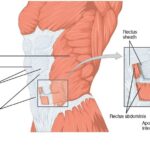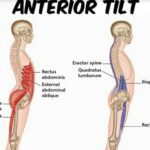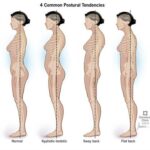Even though we specialize in sports massage, and not prenatal massage, we get regular requests for prenatal massage by our members for themselves or their partners/spouses/friends.
Various aches can lead a mother to seek prenatal massage, and regular sessions can be very beneficial for the mother and baby. However there is a lot of misinformation about prenatal massage and therapist and client alike need to be adequately educated.
The aches and pains of pregnancy

The body goes through many changes during pregnancy
One obvious change is the expanding belly that pulls the abdomen forward, increasing the curvature of the spine, but also pushes down on organs, blood vessels and nerves and creates more weight for your supporting joints to carry.
Another change is the secretion of a pregnancy hormone, Relaxin, that loosens up the ligaments around the joints so that the pelvis can expand during labor.
One more change: the body tends to retain more fluid during pregnancy [4].
Resulting pregnancy pains
The combination of the changes mentioned above often result in low back, hip and knee pain, as well as sciatic pain (this is when the Sciatic nerve is compressed, resulting in a tingling pain shooting from the hip down the back of the leg).
It can also cause swelling in ankles and legs. [5] [6] [7]
Prenatal massage helps ease those symptoms
Prenatal massage can help in relieving low back, hip or knee pain by using light to medium pressure to those areas. Other techniques, lymphatic drainage and light circulatory effleurage, can help reduce swelling to the legs. While certain lotions may be applied to the abdomen for hydration purposes and some other abdominal techniques can be used to relax the Mom and to relieve low back pain, generally this area is avoided during a massage session. Rather the session will focus on the back, hips and legs as well as neck or arms if indicated.
Massage during the first trimester
“You may not be announcing your pregnancy to your family and friends at this stage, but it is crucial that you do so to your therapist as soon as you find out you’re pregnant so they can adapt their session. “
Prenatal massage may be done during all trimesters, with the approval of the obstetrician (OB) and with a professional massage therapist, preferably certified in prenatal massage.
Some therapists refuse to provide treatment during the first term due to the risk of miscarriage associated with the first 12 weeks of pregnancy; however that risk is not linked to massage as long as there is the green light from the OB and that the massage is performed by a licensed professional [1].
In the first term, some mothers suffering from important nausea may not be comfortable receiving a massage, while it may not be an issue for others. Communicating with your therapist before and during the session (preferred position, sensitivity to certain smells or oils, etc) and preparing for the session (light snack before hand, being hydrated) may help keep nausea at bay [9].
Second and third trimester: side lying position
![[15]](https://images.squarespace-cdn.com/content/v1/568c1797df40f37b331c4d04/1488289843379-T46S6APPO5ISKMNIMI6D/Screen-Shot-2015-09-28-at-4.27.52-PM-300x90.png)
[15]
After the first trimester, the massage is performed in a side lying position to avoid pressure on the major vein and arteries that run down the spine behind the uterus. If this position is not comfortable, the massage can be done sitting back with a pillow to elevate the back. Prenatal practices may offer a face down
![[15]](https://images.squarespace-cdn.com/content/v1/568c1797df40f37b331c4d04/1488289843086-JZTZTYQW6MAG5RE9SVRK/Screen-Shot-2015-09-28-at-4.27.28-PM.png)
[15]
position with a table that has a hole cut out to fit the abdomen, however this is not a preferable option as it may still put pressure on the uterus [1].
Some therapists avoid massaging the ankle because of a pressure point that is said to trigger labor (another pressure point would be on the hand between the thumb and index). On the contrary, some pregnant women massage that point at the end of their pregnancy in the hope that it will trigger the baby’s arrival. However this is a widely spread theory that stems from acupuncture/acupressure, a modality that has no basis in modern medicine and whose efficacy has not been proven, in spite of thousands of clinical trials. [10] [11] [12] [13] [14]
Research and prenatal massage
There are several interesting research papers that have come out studying the effects of prenatal massage.
A study [2] where women were offered regular prenatal massage showed reduced anxiety, reduced pain, decreased complications during labor and decreased incidence of prematurity.
Similarly, another study [9] on women receiving regular prenatal massage associated with yoga showed reduced anxiety, depression, back and leg pain and greater gestational age and birthweight.
Yet another study [3] on depressed women receiving regular prenatal massage showed reduced depression and reduced incidences of prematurity and low birthweight.
Prenatal massage is a great tool to relieve pregnancy pains as well as to participate in a healthier pregnancy and delivery and it can also benefit the newborn. Your therapist will also discuss self-care tools such as using a belly belt during certain activities, correcting your posture during the day and using a body pillow at night; stretching and strengthening can also be beneficial, with your OB’s clearance.
“If you are looking for a prenatal massage, I recommend seeking a prenatal massage specialist that will have a set-up tailored to pregnant women. However, if you feel more comfortable working with a therapist you or your friend/spouse/partner trusts at Phila Massages, be assured that all of our therapists have basic training in prenatal massage (as required by our PA licensure); with one being a certified prenatal and infant massage therapist and another having interned in a high-risk maternity ward. “

References:
- [1] http://americanpregnancy.org/pregnancy-health/prenatal-massage/
- [2] http://www.ncbi.nlm.nih.gov/pubmed/10212885
- [3] http://www.ncbi.nlm.nih.gov/pubmed/15715034
- [4] http://www.livescience.com/50877-regnancy-body-changes.html
- [5] http://americanpregnancy.org/pregnancy-health/sciatic-nerve-pain-during-pregnancy/
- [6] http://pregnancy.lovetoknow.com/about-pregnancy/joint-pain-during-pregnancy
- [7] http://www.mayoclinic.org/healthy-lifestyle/pregnancy-week-by-week/expert-answers/swelling-during-pregnancy/faq-20058467
- [8] http://sogc.org/publications/nausea-and-vomiting-during-pregnancy/
- [9] http://www.sciencedirect.com/science/article/pii/S1360859211001409
- [10] https://www.sciencebasedmedicine.org/what-to-expect-when-youre-expecting/
- [11] http://www.ncbi.nlm.nih.gov/pubmed/18978107
- [12] http://journals.lww.com/anesthesia-analgesia/Fulltext/2013/06000/Acupuncture_Is_Theatrical_Placebo.25.aspx
- [13] http://www.ncbi.nlm.nih.gov/pubmed/19433697?ordinalpos=1&itool=EntrezSystem2.PEntrez.Pubmed.Pubmed_ResultsPanel.Pubmed_DefaultReportPanel.Pubmed_RVDocSum
- [14] http://www.ncahf.org/pp/acu.html
- [15] http://sagebirthdoula.com/wp/side-laying-comfort/
This article/video is for educational purposes only; do not attempt without your physician’s clearance. If you are in pain or injured, see your physician.
Copyright © Vidal Sports LLC 2018







